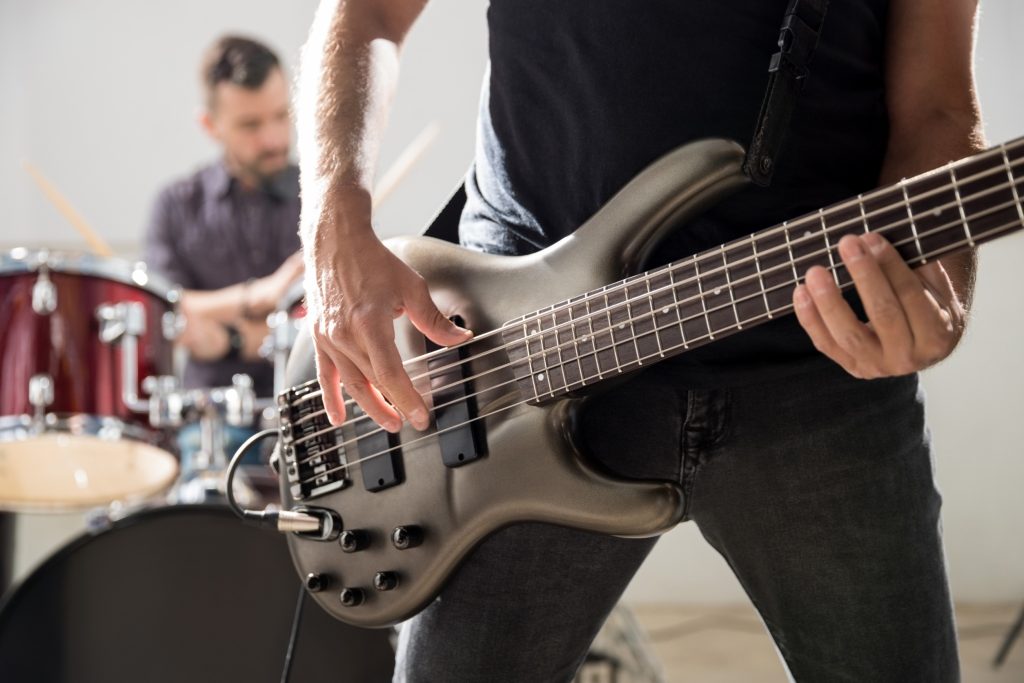Bass Guitar Lessons: Knowledge is Power
I firmly believe that bass guitar lessons can be a transformative experience on your musical journey. Whether you’re a beginner or an intermediate player, taking lessons can significantly enhance your skills, knowledge, and overall musicianship. In this article, I’ll guide you through the benefits of bass guitar lessons and provide helpful suggestions to make the most of your learning experience.
Benefits of Bass Guitar Lessons
Bass guitar lessons offer numerous advantages that can accelerate your progress and help you reach new heights as a bassist. Here are some key benefits:
Personalized Guidance and Feedback
Working with a bass guitar teacher provides personalized guidance and feedback tailored to your specific needs and goals. A skilled teacher can identify your strengths, weaknesses, and areas for improvement, providing valuable insights and strategies to help you grow as a musician.
Structured Learning and Progression
Bass guitar lessons offer a structured approach to learning, ensuring a well-rounded development of your skills. A teacher will guide you through a curriculum that covers essential techniques, music theory, rhythm, and more. This structured progression ensures a solid foundation and steady growth as a bassist.
Accountability and Motivation
Having regular lessons with a teacher creates a sense of accountability and motivation. Knowing that you have a dedicated time to learn and improve encourages consistent practice and helps you stay focused on your musical goals.
Customized Learning Experience
Bass guitar lessons can be tailored to your musical preferences and goals. Whether you’re interested in a specific genre, technique, or style, a teacher can customize the lessons to align with your interests, ensuring an engaging and enjoyable learning experience.
Finding the Right Bass Guitar Lessons
Finding the right bass guitar teacher is crucial for a successful learning journey. Here are some factors to consider when searching for a teacher:
Experience and Qualifications
Look for a teacher with extensive experience and qualifications in teaching bass guitar. Consider their musical background, performance experience, and their ability to effectively communicate and connect with students.
Teaching Style and Approach
Different teachers have varying teaching styles and approaches. Some may focus more on music theory, while others emphasize practical application and playing by ear. Choose a teacher whose style resonates with your learning preferences and goals.
Recommendations and Reviews
Seek recommendations from fellow musicians or read reviews and testimonials from students who have taken lessons with the teacher you’re considering. Positive feedback and success stories can indicate the teacher’s effectiveness in guiding students’ growth.
Trial Lessons
Many teachers offer trial lessons to assess compatibility and teaching methods. Take advantage of these opportunities to gauge how well you connect with the teacher and evaluate if their teaching style aligns with your learning needs.

Structured Learning vs. Self-Study
When it comes to learning bass guitar, you have two primary options: structured learning through lessons or self-study. Let’s explore the benefits of each approach:
Structured Learning
Structured learning, such as bass guitar lessons, provides a guided and systematic approach to your musical development. Here’s why it can be advantageous:
Foundational Knowledge:
Lessons ensure you learn the essential techniques, theory, and fundamentals in a structured manner. This foundation establishes a strong base for your future growth as a bassist.
Personalized Feedback:
A teacher can identify and correct any technical mistakes, provide guidance on proper playing techniques, and offer tailored feedback to help you improve more efficiently.
Motivation and Accountability:
Regular lessons provide accountability and motivation, as you have a set schedule and someone to guide your progress. This structure keeps you focused and dedicated to your practice.
Advanced Techniques and Styles:
A skilled teacher can introduce you to advanced techniques, diverse playing styles, and genres you may not have explored on your own. They can help you expand your musical horizons and challenge yourself.
Self-Study
Self-study can also be a valuable approach, especially for self-motivated individuals who prefer learning at their own pace. Consider these benefits of self-study:
Flexibility and Independence:
Self-study allows you to set your own schedule, explore topics that interest you, and learn at your preferred pace. You have the freedom to focus on specific techniques or genres that align with your musical goals.
Resource Exploration:
With self-study, you have access to a wide range of resources such as books, online tutorials, videos, and forums. This variety enables you to explore different perspectives and teaching methods.
Personal Experimentation:
Self-study encourages experimentation and self-expression. You can develop your own playing style, explore creative improvisation, and adapt techniques to suit your preferences.
Cost and Accessibility:
Self-study is often more affordable and accessible compared to formal lessons. It allows you to learn at your own convenience, without the constraints of scheduling and financial commitments.
Ultimately, the choice between structured learning and self-study depends on your learning style, goals, and availability. Many bassists find a combination of both approaches to be the most effective, incorporating lessons for foundational learning and self-study for exploration and personal growth.
Essential Techniques and Fundamentals
To become a proficient bassist, mastering essential techniques and fundamentals is crucial. Here are some key aspects to focus on:
Proper Hand and Finger Placement
Developing proper hand and finger placement is essential for accurate and efficient playing. Pay attention to your posture, ensure a relaxed hand position, and use your fingertips to press the strings firmly and cleanly.
Playing Techniques: Plucking, Picking, and Slapping
Different playing techniques produce varied tones and styles. Mastering techniques such as fingerstyle plucking, using a pick, and incorporating slap and pop techniques will expand your range of musical expression.
Understanding Rhythm and Timing
Solid rhythm and timing are fundamental to being a great bassist. Practice playing in sync with a metronome, internalizing different rhythmic patterns, and developing a strong sense of groove.

Note and Scale Knowledge
Understanding the notes on the bass fretboard and learning common scales is essential for melodic playing, improvisation, and building a solid foundation in music theory. Familiarize yourself with major and minor scales, as well as the pentatonic scale, which is widely used in bass playing.
Developing Ear Training Skills
Training your ears to recognize intervals, chord progressions, and melodies will greatly enhance your ability to learn songs by ear, improvise, and play with other musicians. Practice identifying musical elements solely by listening to recordings.
Developing Rhythm and Timing
Developing a strong sense of rhythm and timing is crucial for bassists. Here are some tips to help you improve:
Groove with a Metronome
Practicing with a metronome is a powerful tool for developing your sense of timing and groove. Start by playing simple basslines in time with the metronome, gradually increasing the tempo as you become more comfortable. Focus on locking in with the metronome and feeling the pulse of the music.
Play Along with Recordings
Playing along with recordings of your favorite songs is an excellent way to develop your sense of rhythm. Pay attention to the interaction between the bass and other instruments in the band. Emulate the groove and feel of the original recording, striving to match the timing and nuances of the bassline.
Study Different Rhythmic Styles
Explore various rhythmic styles and genres to expand your rhythmic vocabulary. Funk, jazz, reggae, and Latin music, for example, have distinct rhythmic patterns and feels. Analyze the basslines in these genres and practice replicating their rhythmic characteristics.
Focus on Subdivisions
Practice subdividing the beat into smaller increments. Start by playing simple exercises using eighth notes, sixteenth notes, and triplets. This will enhance your ability to play syncopated rhythms and intricate basslines accurately.
Experiment with Syncopation
Syncopation adds interest and groove to your playing. Experiment with accenting off-beats, playing slightly ahead or behind the beat, and adding rhythmic variations to create a dynamic and engaging bassline.
Understanding Music Theory with Bass Guitar Lessons
While not essential, a solid understanding of music theory can greatly benefit your bass playing. Here are key concepts to explore:
Basic Notation and Terminology
Familiarize yourself with the basics of musical notation, including note values, time signatures, key signatures, and chord symbols. Understanding these concepts will enable you to read and communicate music more effectively.
Intervals and Chord Construction
Learn about intervals and how they contribute to constructing chords and playing basslines. Understanding intervals will help you navigate the fretboard, identify chord tones, and create melodic basslines.
Scales and Modes
Explore different scales and modes commonly used in bass playing. Major and minor scales, pentatonic scales, blues scales, and modes such as the Dorian and Mixolydian can add depth and versatility to your playing.
Chord Progressions and Harmonic Analysis
Study common chord progressions and their harmonic functions. This knowledge will allow you to navigate songs more confidently, make informed improvisational choices, and contribute musically to a band setting.
Bassline Construction and Arpeggios
Learn how to construct basslines using chord tones, passing tones, and chromatic approaches. Incorporating arpeggios into your playing will enhance your ability to outline chord progressions and create melodic basslines.
Building a Repertoire with Bass Guitar Lessons
As a bassist, building a repertoire of songs is essential for expanding your musical vocabulary and developing your playing skills. Here’s how to approach it:
Choose Diverse Songs
Select songs from different genres and eras to broaden your musical horizons. Explore rock, funk, jazz, blues, pop, and any other styles that resonate with you. This variety will expose you to different playing techniques, rhythmic patterns, and musical concepts.
Focus on Iconic Basslines
Include songs with iconic basslines that have stood the test of time. Learn basslines from influential bassists such as James Jamerson, Jaco Pastorius, Flea, and John Paul Jones. Analyze their techniques, groove, and musicality to inspire your own playing.
Balance Difficulty Levels
Include songs of varying difficulty levels in your repertoire to challenge yourself and continuously improve. Start with simpler songs to build your foundation and gradually progress to more complex pieces as your skills develop. This balanced approach will keep you engaged and motivated throughout your musical journey.
Incorporate Your Personal Favorites
Include songs that resonate with you personally. Playing songs you love will keep you inspired and motivated to practice and improve. Choose pieces that showcase your musical taste and allow you to express your creativity as a bassist.
Explore New Songs Regularly
Continuously expand your repertoire by exploring new songs. Stay updated with current music trends, explore lesser-known artists, and seek out recommendations from fellow musicians. This ongoing exploration will keep your repertoire fresh and diverse.
Perform and Jam with Others
Once you’ve built a solid repertoire, seek opportunities to perform and jam with other musicians. Playing with others not only enhances your musicality but also helps you develop essential skills like listening, improvisation, and collaborating within a band setting.
Effective Practice Strategies for Bass Guitar Lessons
To maximize your progress as a bassist, it’s important to practice effectively. Here are some strategies to make the most of your practice sessions:
Set Specific Goals
Clearly define what you want to achieve in each practice session. Whether it’s mastering a new technique, learning a challenging song, or improving your timing, having specific goals will keep you focused and provide a sense of accomplishment.
Break It Down
Break complex basslines or techniques into smaller, manageable parts. Practice each section separately, gradually increasing the tempo and then integrating them back together. This approach ensures thorough learning and avoids feeling overwhelmed.
Focus on Technique
Dedicate time to refining your technique. Work on exercises that target finger strength, dexterity, and accuracy. Practice scales, arpeggios, and technical drills to improve your overall control and fluidity on the instrument.
Slow It Down
When learning a new song or complex bassline, start by playing it at a slower tempo. This allows you to focus on accuracy, timing, and muscle memory. As you become more comfortable, gradually increase the speed.
Record Yourself
Recording your practice sessions can be invaluable for self-assessment. Listen back to identify areas that need improvement, such as timing issues, weak transitions, or inconsistent dynamics. This self-feedback will guide your practice and help you refine your playing.
Be Consistent
Consistency is key to progress. Set aside regular practice time and stick to a consistent schedule. Even short, focused practice sessions on a daily basis can yield better results than infrequent, lengthy sessions.
Practice with a Metronome or Backing Tracks
Incorporate a metronome or backing tracks into your practice routine. This will help you develop a solid sense of timing, improve your ability to play in different musical contexts, and enhance your overall rhythm and groove.
Exploring Different Styles and Genres
As a bassist, exploring different styles and genres is essential for broadening your musical horizons. Here’s why it’s beneficial:
Versatility and Adaptability
Being well-versed in various styles and genres makes you a versatile bassist. Whether you’re playing in a rock band, jazz ensemble, or funk group, having the ability to adapt to different musical contexts is invaluable.
Expanding Musical Vocabulary
Each style and genre has its unique characteristics, rhythmic patterns, and playing techniques. Exploring different genres exposes you to new musical vocabulary, expanding your understanding and ability to communicate through your bass playing.
Musical Inspiration and Creativity
Listening to and learning different styles of music inspires creativity and sparks new ideas. Drawing influences from diverse genres allows you to incorporate different elements into your playing, resulting in a more unique and personalized style.
Collaboration Opportunities
Having knowledge and experience in various genres opens doors for collaboration with a wide range of musicians. Being able to adapt to different styles and genres makes you a valuable asset in musical collaborations, whether it’s joining a band, participating in jam sessions, or recording sessions.
Developing a Well-Rounded Musical Identity
Exploring different styles and genres helps you develop a well-rounded musical identity as a bassist. By incorporating elements from various genres into your playing, you can create a distinct and eclectic style that sets you apart from others.
Tips for Exploring Different Styles and Genres
Listen Intently:
Immerse yourself in the music of different styles and genres. Pay attention to the basslines, rhythms, and overall feel. Take note of the unique characteristics that define each genre.
Study Influential Bassists:
Explore the work of influential bassists in various genres. Listen to their playing, analyze their techniques, and incorporate their stylistic elements into your own basslines.
Imitate and Internalize:
Select songs from different genres and learn to play them authentically. Imitate the basslines, focusing on capturing the specific feel and groove of each style. This will help you internalize the essence of the genre.
Experiment and Blend:
Once you’ve gained proficiency in different styles, experiment with blending elements together. Combine techniques, rhythms, and melodic ideas from different genres to create your own unique fusion of styles.
Jam with Musicians in Different Genres:
Seek opportunities to jam with musicians who specialize in different genres. Collaborating with musicians from diverse musical backgrounds will expose you to new ideas, expand your improvisational skills, and foster musical growth.
Performance and Stage Presence
Performing as a bassist goes beyond playing the right notes. It’s about engaging the audience and creating a memorable experience. Here’s how to enhance your performance and stage presence:
Project Confidence and Energy
Confidence is key to commanding the stage. Stand tall, make eye contact with the audience, and project positive energy. Embrace your role as a bassist and let your enthusiasm shine through your playing.
Communicate with Bandmates
Good communication with your bandmates is essential for a cohesive performance. Stay connected through visual cues, listen attentively to each other, and maintain a strong musical connection. This synergy enhances the overall performance and creates a tight and impactful sound.
Move with Purpose
Move with purpose on stage to visually enhance your performance. Utilize subtle movements, such as swaying or stepping to the rhythm, to connect with the music. Be mindful of your body language and use it to convey the emotion and energy of the music.
Engage the Audience
Interact with the audience to create a connection and keep them engaged. Make eye contact, smile, and acknowledge their presence. Use your stage presence to draw them into the performance and make them feel involved.

Showmanship and Stagecraft
Explore showmanship and stagecraft techniques that suit your personal style and the genre of music you’re playing. This can include elements like stage props, dynamic movements, or unique visual elements that add a visual spectacle to your performance.
Practice Performing
Regularly practice performing in front of others to build confidence and familiarity with being on stage. This can be done through open mic nights, jam sessions, or even recording yourself performing and reviewing the footage.
Troubleshooting Common Challenges
Throughout your bass guitar journey, you may encounter common challenges. Here are some troubleshooting tips for overcoming these obstacles:
Finger Fatigue and Stamina
If you experience finger fatigue or lack of stamina during extended playing sessions, gradually increase your practice time to build endurance. Additionally, focus on proper technique and hand position to minimize unnecessary strain on your fingers.
Timing and Rhythm Issues
If you struggle with timing and rhythm, practice with a metronome or drum loops to develop a strong internal sense of timing. Start by playing simple exercises at a slow tempo, gradually increasing the speed as you become more comfortable. Pay attention to subdivisions and accent patterns to improve your rhythmic accuracy.
Weak Technique or Lack of Speed
To address weak technique or lack of speed, dedicate practice time to specific exercises that target finger strength, dexterity, and speed. Start with slow, controlled movements and gradually increase the tempo as you gain proficiency. Focus on accuracy and clarity of each note.
Lack of Musical Inspiration
If you find yourself lacking inspiration, try listening to a wide range of music, attending live performances, or exploring new genres. Collaborating with other musicians, joining a band, or participating in jam sessions can also reignite your passion and provide fresh musical ideas.
Plateau in Progress
If you hit a plateau in your progress, it’s important to stay patient and persistent. Evaluate your practice routine and consider seeking guidance from a bass teacher or experienced mentor who can provide insights, personalized feedback, and new challenges to help you break through the plateau.
Stage Fright and Performance Anxiety
Stage fright and performance anxiety are common challenges for musicians. To address these issues, practice performing in front of friends, family, or small audiences to gradually build confidence. Breathing exercises, visualization techniques, and positive self-talk can also help manage anxiety before and during performances.
Leveraging Technology for Bass Guitar Lessons
Technology offers a wealth of resources and tools to enhance your bass guitar learning experience. Here’s how you can leverage technology:
Online Lessons and Tutorials
Take advantage of online bass guitar lessons and tutorials. Many experienced bassists and instructors offer video lessons covering a wide range of topics and techniques. Explore reputable websites, YouTube channels, and online platforms dedicated to bass guitar education.
Mobile Apps and Software
Utilize mobile apps and software specifically designed for bass players. These apps can provide virtual metronomes, backing tracks, scales and chord libraries, ear training exercises, and even interactive lessons. Incorporating these tools into your practice routine can add variety and convenience.
Recording and Playback
Record yourself playing to assess your progress, identify areas for improvement, and track your growth as a bassist. Use recording software or apps on your computer, smartphone, or dedicated recording devices. Listening back to your recordings allows you to analyze your playing objectively and make necessary adjustments.
Virtual Collaboration
Take advantage of virtual collaboration tools to connect with other musicians and participate in online collaborations. This allows you to expand your network, exchange ideas, and engage in musical projects with musicians from around the world.
Online Communities and Forums
Engage with online communities and forums dedicated to bass guitar. Participate in discussions, ask questions, and share your experiences. These communities provide a platform to connect with fellow bassists, gain insights, and learn from each other’s experiences.
Long-Term Growth and Continued Learning
Bass guitar lessons mark the beginning of a lifelong journey of learning and growth as a musician. Here are some tips for long-term development:
Maintain a Growth Mindset
Approach your bass guitar journey with a growth mindset. Embrace challenges, view mistakes as opportunities to learn, and stay open to new ideas and perspectives. A mindset focused on growth will fuel your progress and keep you motivated.
Seek Musical Inspiration
Continuously seek inspiration by listening to diverse genres, attending concerts, and exploring different forms of art. Inspiration can come from unexpected sources, so keep an open mind and let your creativity flourish.
Set New Goals
Regularly set new goals to keep your learning journey exciting and rewarding. Whether it’s learning a challenging song, mastering a specific technique, or exploring a new genre, setting goals provides direction and a sense of accomplishment.
Embrace LifelongLearning
View your bass guitar journey as a lifelong pursuit of knowledge and growth. Embrace the mindset of a perpetual learner, always seeking to expand your skills, deepen your musical understanding, and explore new possibilities.
Stay Connected with the Bass Community
Engage with the bass community to stay connected and inspired. Attend workshops, seminars, and bass-related events. Connect with fellow bassists, join online communities, and participate in forums to share experiences, gain insights, and build supportive relationships.
Explore Additional Instruments
Broaden your musical horizons by exploring other instruments. Learning a related instrument such as guitar, keyboards, or drums can provide a deeper understanding of music as a whole. It can also expand your versatility as a musician and offer new creative avenues.
Continuously Challenge Yourself
Regularly challenge yourself by stepping out of your comfort zone. Explore complex music genres, experiment with improvisation, learn advanced techniques, and seek out new musical collaborations. Pushing yourself beyond your current abilities fosters growth and keeps your passion for bass guitar alive.
Reflect and Evaluate
Periodically reflect on your progress and evaluate your musical journey. Celebrate your achievements, identify areas for improvement, and set new goals. Regular self-assessment ensures that you stay on track and maintain a clear direction in your development as a bassist.
Stay Inspired and Enjoy the Journey
Above all, remember to enjoy the process and stay inspired. Music is a lifelong adventure, and your bass guitar journey is an opportunity to express yourself, connect with others, and experience the joy of creating music. Embrace the challenges, savor the victories, and find fulfillment in the continuous pursuit of musical growth.
Conclusion
Bass guitar lessons offer an incredible opportunity to enhance your skills, broaden your musical horizons, and unlock your full potential as a bassist. Whether you choose structured learning with a teacher or self-study, the key is to approach your journey with passion, dedication, and a growth mindset. Embrace the essential techniques, explore different styles, and continually challenge yourself to evolve as a musician. Remember, the path to mastery is a lifelong adventure, so enjoy every step along the way.
FAQs
Q: How often should I practice bass guitar?
A: It’s recommended to practice regularly, aiming for at least 30 minutes to an hour each day. Consistency is key to progress.
Q: How can I improve my speed and dexterity on the bass?
A: Start with slow and controlled practice, gradually increasing the tempo. Incorporate exercises that target finger strength and accuracy. Practice scales, arpeggios, and technical drills.
Q: Should I learn to read sheet music as a bassist?
A: While not essential, learning to read sheet music can be beneficial in expanding your musical vocabulary and communication with other musicians.
Q: How important is music theory for bass players?
A: Music theory provides a deeper understanding of the instrument and music as a whole. It can enhance your ability to communicate, improvise, and navigate the fretboard.
Q: How can I overcome stage fright as a bassist?
A: Practice performing in front of others, start with small audiences, and gradually build your confidence. Breathing exercises, visualization techniques, and positive self-talk can help manage stage fright.
Remember, learning the bass guitar is a journey, and everyone progresses at their own pace. Embrace the process, enjoy the music you create, and let your passion guide you. Happy playing!





